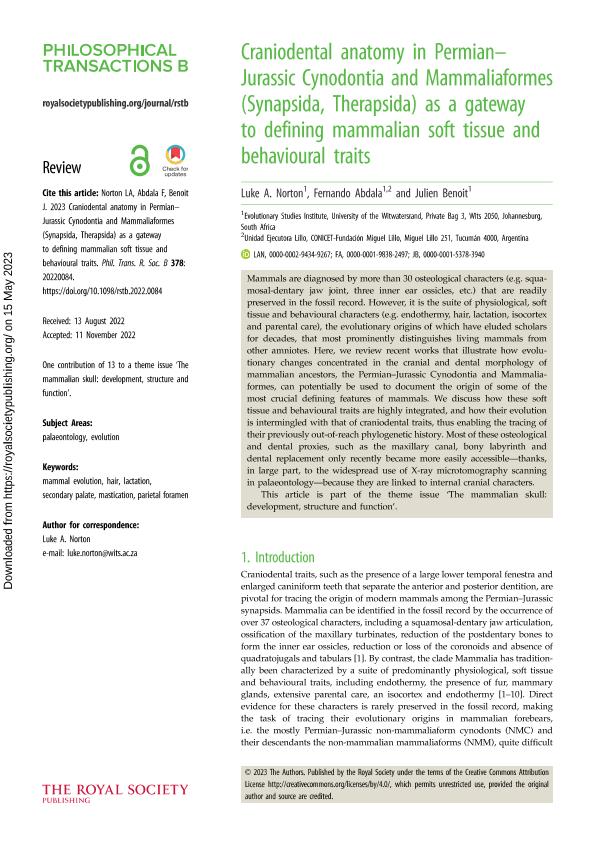Mostrar el registro sencillo del ítem
dc.contributor.author
Norton, Luke A.
dc.contributor.author
Abdala, Nestor Fernando

dc.contributor.author
Benoit, Julien

dc.date.available
2023-09-29T19:31:52Z
dc.date.issued
2023-07
dc.identifier.citation
Norton, Luke A.; Abdala, Nestor Fernando; Benoit, Julien; Craniodental anatomy in Permian-Jurassic Cynodontia and Mammaliaformes (Synapsida, Therapsida) as a gateway to defining mammalian soft tissue and behavioural traits; The Royal Society; Philosophical Transactions of the Royal Society B: Biological Sciences; 378; 1880; 7-2023; 1-12
dc.identifier.issn
0962-8436
dc.identifier.uri
http://hdl.handle.net/11336/213691
dc.description.abstract
Mammals are diagnosed by more than 30 osteological characters (e.g. squamosal-dentary jaw joint, three inner ear ossicles, etc.) that are readily preserved in the fossil record. However, it is the suite of physiological, soft tissue and behavioural characters (e.g. endothermy, hair, lactation, isocortex and parental care), the evolutionary origins of which have eluded scholars for decades, that most prominently distinguishes living mammals from other amniotes. Here, we review recent works that illustrate how evolutionary changes concentrated in the cranial and dental morphology of mammalian ancestors, the Permian-Jurassic Cynodontia and Mammaliaformes, can potentially be used to document the origin of some of the most crucial defining features of mammals. We discuss how these soft tissue and behavioural traits are highly integrated, and how their evolution is intermingled with that of craniodental traits, thus enabling the tracing of their previously out-of-reach phylogenetic history. Most of these osteological and dental proxies, such as the maxillary canal, bony labyrinth and dental replacement only recently became more easily accessible - thanks, in large part, to the widespread use of X-ray microtomography scanning in palaeontology - because they are linked to internal cranial characters. This article is part of the theme issue 'The mammalian skull: development, structure and function'.
dc.format
application/pdf
dc.language.iso
eng
dc.publisher
The Royal Society

dc.rights
info:eu-repo/semantics/openAccess
dc.rights.uri
https://creativecommons.org/licenses/by/2.5/ar/
dc.subject
HAIR
dc.subject
LACTATION
dc.subject
MAMMAL EVOLUTION
dc.subject
MASTICATION
dc.subject
PARIETAL FORAMEN
dc.subject
SECONDARY PALATE
dc.subject.classification
Paleontología

dc.subject.classification
Ciencias de la Tierra y relacionadas con el Medio Ambiente

dc.subject.classification
CIENCIAS NATURALES Y EXACTAS

dc.title
Craniodental anatomy in Permian-Jurassic Cynodontia and Mammaliaformes (Synapsida, Therapsida) as a gateway to defining mammalian soft tissue and behavioural traits
dc.type
info:eu-repo/semantics/article
dc.type
info:ar-repo/semantics/artículo
dc.type
info:eu-repo/semantics/publishedVersion
dc.date.updated
2023-09-25T14:47:49Z
dc.journal.volume
378
dc.journal.number
1880
dc.journal.pagination
1-12
dc.journal.pais
Reino Unido

dc.journal.ciudad
Londres
dc.description.fil
Fil: Norton, Luke A.. University of the Witwatersrand; Sudáfrica
dc.description.fil
Fil: Abdala, Nestor Fernando. Consejo Nacional de Investigaciones Científicas y Técnicas. Centro Científico Tecnológico - Tucumán. Unidad Ejecutora Lillo; Argentina. University of the Witwatersrand; Sudáfrica
dc.description.fil
Fil: Benoit, Julien. University of the Witwatersrand; Sudáfrica
dc.journal.title
Philosophical Transactions of the Royal Society B: Biological Sciences

dc.relation.alternativeid
info:eu-repo/semantics/altIdentifier/url/https://royalsocietypublishing.org/doi/10.1098/rstb.2022.0084
dc.relation.alternativeid
info:eu-repo/semantics/altIdentifier/doi/http://dx.doi.org/10.1098/rstb.2022.0084
Archivos asociados
